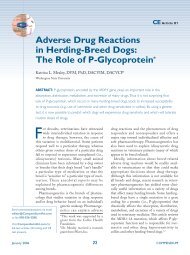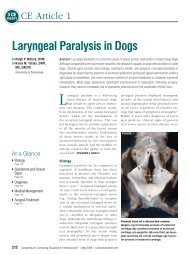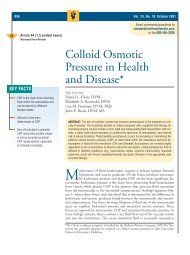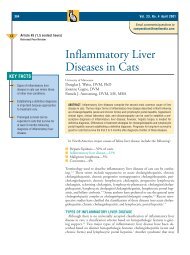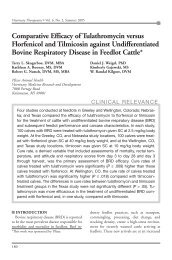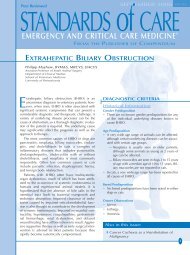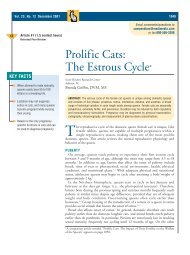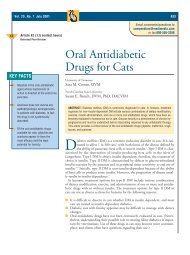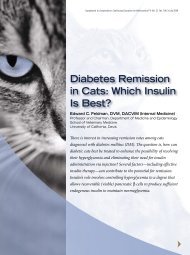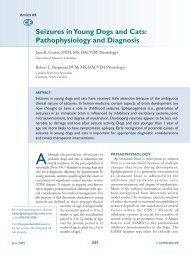Create successful ePaper yourself
Turn your PDF publications into a flip-book with our unique Google optimized e-Paper software.
454 Small Animal/Exotics Compendium June 2002<br />
Table 2. Antiemetic Drugs<br />
Drug Dose Comment<br />
Metoclopramide Dogs and cats: 0.1–0.5 mg/kg PO or Use lower doses with renal failure;<br />
SC q8h, 0.02 mg/kg IV q1h, or 1–2 <strong>com</strong>mon side effects are anxiety and<br />
mg/kg/day IV by CRI restlessness in dogs and cats<br />
Domperidone Dogs and cats: 0.1–0.5 mg/kg IM or<br />
IV q12h or 2–5 mg/kg PO q12h<br />
Not available in the United States<br />
Ondansetron Dogs and cats: 0.1–0.2 mg/kg SC q8h, No side effects are known; further<br />
0.1–1.0 mg/kg q12–24h PO, 0.5 mg/kg<br />
IV load, or 0.5 mg/kg IV infusion q1h<br />
investigation is needed in dogs and cats<br />
Dolasetron Dogs and cats: to prevent nausea or Can be <strong>com</strong>bined with metoclopramide<br />
vomiting—0.6 mg/kg/day IV or PO; for optimal prevention of chemotherapyvomiting—1<br />
mg/kg/day IV or PO indu<strong>ce</strong>d nausea and vomiting in dogs<br />
and cats<br />
Chlorpromazine Dogs: 0.2–0.4 mg/kg IM or SC q6–8h,<br />
3.3 mg/kg PO q6–8h; cats: 0.5 mg/kg<br />
IM or SC q6–8h, 2.0–4.0 mg/kg/day PO<br />
May cause sedation<br />
Prochlorperazine Dogs: 0.25–0.5 mg/kg IM q8–12h<br />
or 1 mg/kg PO q12h; cats: 0.13 mg/kg<br />
IM q12h or 0.5 mg/kg PO q12h with food<br />
May cause sedation in dogs and cats<br />
Trifluoperazine Dogs and cats: 0.03 mg/kg IM q12h May cause sedation in dogs and cats<br />
Cyclizine hydrochloride Dogs and cats: 4 mg/kg IM q8h For vestibular disease–indu<strong>ce</strong>d emesis<br />
Meclizine hydrochloride Dogs 10 kg: 2–6 mg/kg/day PO;<br />
cats: 4 mg/kg/day PO<br />
For vestibular disease–indu<strong>ce</strong>d emesis<br />
Diphenhydramine hydrochloride Dogs and cats: 2–5 mg/kg PO q6–8h, For vestibular disease–indu<strong>ce</strong>d emesis<br />
2 mg/kg IM or IV (slowly) q12h<br />
CRI = constant-rate infusion.<br />
(1 mg/kg IV) in dogs and cats. 4 Contraindications are GI<br />
hemorrhage and obstruction. Other dopamine antagonists<br />
that have been available but less <strong>com</strong>monly used are domperidone<br />
and the butyrophenone derivatives haloperidol<br />
and droperidol. Domperidone, which is similar to metoclopramide<br />
in activity, is currently not available in the<br />
United States for use in dogs and cats. The butyrophenones<br />
cause potent tranquilizer side effects and seizures in<br />
preepileptic patients.<br />
Serotonin Antagonists<br />
Serotonin antagonists, also known as 5-HT 3 antagonists,<br />
are a relatively new class of antiemetic drug that<br />
blocks stimulation at the CTZ and in the in<strong>test</strong>ine to<br />
prevent vomiting. 5 The neurotransmitter serotonin acts<br />
by increasing the secretion of a<strong>ce</strong>tylcholine at distal<br />
ganglia, thereby stimulating the CTZ to indu<strong>ce</strong> vomiting.<br />
Serotonin antagonists block this mechanism and<br />
are considered the most potent inhibitors of vomiting.<br />
They are particularly useful for preventing vomiting<br />
indu<strong>ce</strong>d by chemotherapy, parvovirus, and causes that<br />
are resistant to other therapies. 5-HT 3 antagonists that<br />
are available include ondansetron, tropisetron,<br />
granisetron, azesetron, and dolasetron. Ondansetron<br />
and dolasetron have been reported to be very effective<br />
in both dogs and cats 6 ; however, the high cost of these<br />
drugs limits their use to chemotherapy patients or<br />
patients unresponsive to other medications. Side effects<br />
have not been reported in dogs and cats; however, indepth<br />
study of these drugs in <strong>com</strong>panion animals have<br />
not been published.<br />
Phenothiazines<br />
Phenothiazines control vomiting by inhibiting the<br />
CTZ as a result of their antidopaminergic and antihistaminergic<br />
effects. 2 Phenothiazine derivatives used as<br />
antiemetics in small animals include chlorpromazine,<br />
prochlorperazine, triflupromazine, perphenazine, trifluoperazine,<br />
and mepazine. Side effects associated with phenothiazines<br />
are sedation, hypotension caused by peripheral<br />
α blockade, and seizures in preepileptic patients.<br />
Glucocorticoids<br />
Glucocorticoids are used in human medicine to con-



